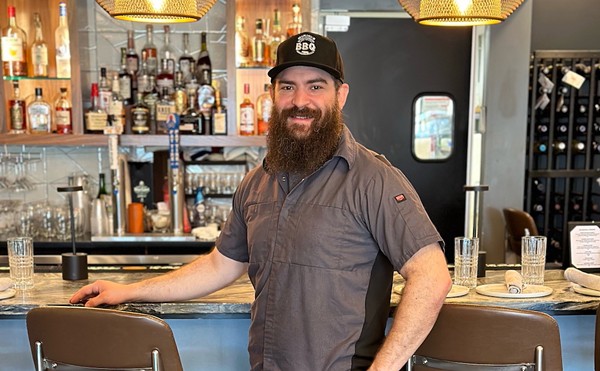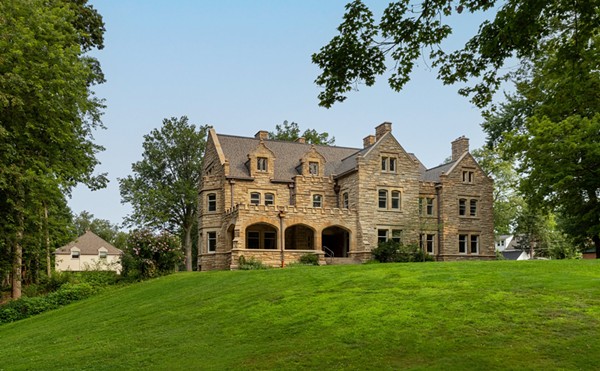It's a brisk late-winter morning in Cleveland, but inside the greenhouses of Green City Growers it feels more like Tampa. The temps are hovering around the 80-degree mark and the air is agreeably thick with humidity. But it's the lushness that really wins a guy over, with kelly green vegetation as far as the eye can see.
At 3.25 acres, this site is one of the largest urban greenhouses in the country, and it happens to sit in the heart of the economically depressed Central neighborhood. Inside the state-of-the-art hydroponic greenhouse, some 300,000 plants at various stages of growth float in shallow pools of nutrient-rich water. There are leafy heads of butter lettuce, colorful mixed-green blends, peppery upland cress and fragrant Italian basil.
Opened in 2012, Green City Growers has had a promising, albeit challenging, run. Part of the ambitious Evergreen Cooperatives, which includes Evergreen Cooperative Laundry and Ohio Cooperative Solar, the greenhouse was the only one of the three employee-owned companies to not be profitable. That should change this year, says Jeremy Lisy, VP of sales.
"When I came here we had 15 people working and the greenhouse was 60-percent empty," he explains. "They didn't know what to grow and who to sell it to. Some of the products they were growing weren't right for chefs."
As a chef and former owner of the specialty produce company KJ Greens, Lisy reached out to his former colleagues to see what types of products they were interested in. He added different lettuces and blends and beefed up sales. This year, the company is expected to hit $3 million in sales, doubling what it was just two years prior. That is money that would have gone to lettuce growers in California and Arizona.
"Now we're at 80-percent capacity and have 38 full-time employees, and sales are heading in the right direction. Hopefully, this is the year we break even. Once we get to that point, it's a life-changing opportunity for a lot of people, because they are 90-percent owners of this."
Green City Growers provides 38 people with living-wage jobs and a path to ownership. Working with programs like Refugee Response and Towards Employment, the greenhouse employs many people who might otherwise find it hard to secure gainful employment. On the current roster are people with nonviolent criminal records and immigrants from Bhutan, Guatemala and the Democratic Republic of the Congo.
After one year of employment, workers get to join the co-op, which includes benefits like credit management and car and mortgage assistance. When the company begins to turn a profit, that money goes to the worker-owners in the form of bonuses and savings for retirement.
Laurie "Spike" Cook did a dime in the state pen but she currently is the transplant supervisor at the greenhouse and she sits on the board of the co-op. After leaving prison she searched in vain for a job for a full year until she took a class with Towards Employment. A week later she had a full-time job.
"I haven't missed a day of work in over a year," says Cook, who arrives an hour and half before her shift begins every day. "This place gave me a second chance. It makes me want to do better, stay better and do the right thing. Without this job I might have messed up. This job, right here, is the reason I wake up every morning. I plan on staying here until I retire."
Chef Matt Mytro had no idea that by purchasing Flour's salad greens from Green City Growers he was helping to support ex-offenders and refugees. He buys the products because of their quality and freshness.
"I never knew that, but it's a really great talking point for our restaurant to know that they are part of something bigger than just lettuce," he says. "But to have fresh, local lettuce on our menu is great. It's consistent in size, color and taste year-round."
"Green" is more than a product description at the greenhouse; it's engineered into the operation. Three 70,000-gallon cisterns capture rain and snow from the roof, providing 80-percent of the greenhouse's water needs. Also, growing indoors requires one gallon of water per head compared to 30 gallons per head when grown under the sunny Western skies.
For Lisy, the success of GCG can positively affect the lives of so many more people than just those under his charge.
"This is one of the toughest growing regions in the country," he says. "If we can make it here, become profitable, we know that we can put this into place anywhere in the country and it's going to be successful. Now you're not just talking about 50 jobs, you're talking about creating 5,000 to 10,000 employee-owners across the country."
Find Green City Growers products at Marc's, Acme, Buehler's, Ohio City Provisions, West Side Market and the Tremont General Store.









